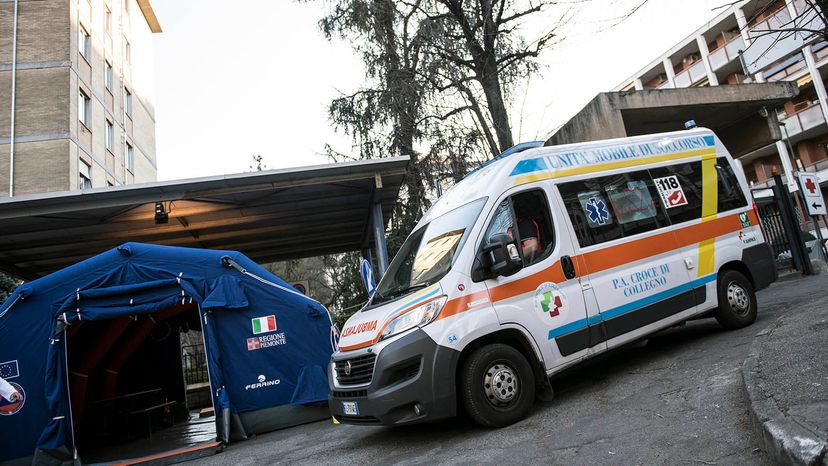 “Italy is setting up isolation tents in front of several hospitals, including the Martini Hospital in Turin, Northern Italy, as the country tries to prevent further the spread of the coronavirus. Stefano Guidi/Getty Images
“Italy is setting up isolation tents in front of several hospitals, including the Martini Hospital in Turin, Northern Italy, as the country tries to prevent further the spread of the coronavirus. Stefano Guidi/Getty Images
If you’ve been paying attention to the news lately, you’ve probably heard about the novel coronavirus or COVID-19, a dangerous respiratory illness that originated in the city of Wuhan, China. Despite the efforts of the Chinese government to contain it, the virus quickly spread worldwide within weeks of the discovery of the first case.
In addition to looking for a vaccine for the virus, health care officials in the U.S. and around the world sought to contain the spread of the virus through the age-old methods of quarantine and isolation. Though the two words are often used interchangeably, they have distinctly different meanings.
"Both quarantine and isolation are used to prevent the spread of an infectious disease," Dr. Bruce Ribner, master clinician at Atlanta’s Emory University School of Medicine, says via email. Ribner also is the medical director of the Serious Communicable Diseases Unit at Emory University Hospital and is one of the clinicians providing direct patient care for the unit. He has extensive expertise in the field of epidemiology and is responsible for treating patients with infectious diseases like Ebola, tuberculosis and HIV.
"Quarantine separates and restricts the movement of well individuals who have been exposed to an infectious disease," he explains. "These individuals are monitored for any signs or symptoms of infection. Isolation separates ill persons and restricts their movement until they are no longer contagious."
How and Why Quarantines Work
Essentially, quarantines work because they limit the exposure of potentially sick people to the rest of the population. This is especially true when the quarantine is established quickly — as soon as the first case appears.
"Quarantine ends when an individual remains well after the longest incubation period for the illness," Ribner says. For example, if it takes 14 to 21 days for the virus to incubate, the quarantine would last 21 days.
"Isolation ends when the [sick] individual is no longer contagious, usually determined by sampling their body fluids to document the absence of the infecting pathogen," Ribner says. "For respiratory tract infections the fluid sampled would be respiratory secretions, while for blood-borne infections such as the viral hemorrhagic fevers, the fluid sampled would be the blood."
However, it can be challenging to quarantine and isolate individuals against airborne viruses or pathogens. "If the infection is spread via the air, good infection control would require the use of respirators when in the same room as the patient and control of the air leaving the room," Ribner says. "Air leaving such a room should flow in one direction through the air vents until it is either filtered to remove the infectious particles or vented to the outside away from people or intake vents. Most air coming from a hotel room or cabin on a ship is not handled in this special way, and there is a lot of potential for the air leaving one room to enter another room before it is filtered or vented. This creates the potential for the pathogen to spread from one person to another."
Who Handles Quarantines in the U.S.?
In the U.S., the Commerce Clause in the U.S. Constitution gives the executive branch the authority to isolate and quarantine citizens in order to protect them from the spread of infectious diseases. The president can authorize an executive order for federal isolation and quarantine for the following diseases:
- cholera
- diphtheria
- infectious tuberculosis
- plague
- smallpox
- yellow fever
- viral hemorrhagic fevers
- severe acute respiratory syndromes
- flu that can cause a pandemic
The president can also revise this list by executive order.
Section 361 of the Public Health Service Act gives authority to the U.S. Secretary of Health and Human Services to "prevent entry and spread of communicable diseases from foreign countries into the U.S. and between states." In the event of a widespread quarantine/isolation emergency, the day-to-day functions would be carried out by the Centers for Disease Control and Prevention (CDC) based in Atlanta, as well as local public health service officers and other public officials.
But federal quarantine is rarely used. The last time a federal quarantine was put in place was during the influenza pandemic ("Spanish flu") from 1918 to 1919.
Ribner has witnessed firsthand what happens when quarantine and isolation are used successfully. "The recent measles outbreak in the United States has only been controlled by isolating those with the infection and vaccinating those who have not been vaccinated," he says. "The SARS outbreak of 2002-2003 and the Ebola outbreak of 2013-2016 were both ultimately controlled by identifying all of the infected and exposed individuals and placing them in isolation or quarantine. While these outbreaks were tragic in the number of infected and dead individuals they caused, in the absence of isolation and quarantine there would have been many more infected individuals."
Now That’s Interesting
Quarantine, as it’s practiced today, began in Europe in the 1300s as a way to protect cities, especially coastal cities, from the plague. Ships arriving in Venice from infected ports had to remain at anchor for 40 days before they were allowed to dock. The word, quarantine, is taken from the Italian words quaranta giorni meaning 40 days.



























